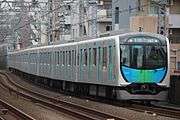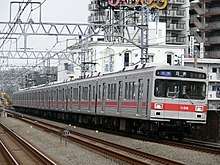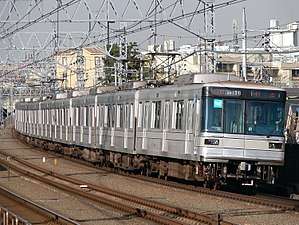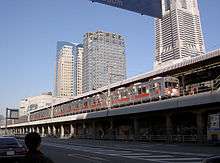Tōkyū Tōyoko Line
| Tokyu Toyoko Line | |
|---|---|
| TY | |
|
A Toyoko Line 5050 series EMU in 2010 | |
| Overview | |
| Type | Commuter rail |
| Locale | Kantō Region |
| Termini |
Shibuya Yokohama |
| Stations | 21 |
| Daily ridership | 1,119,453 (FY2010)[1] |
| Operation | |
| Opened | 14 February 1926 |
| Owner | Tokyu Corporation |
| Technical | |
| Line length | 24.2 km (15.0 mi) |
| Track gauge | 1,067 mm (3 ft 6 in) |
| Electrification | 1,500 V DC overhead catenary |
| Operating speed | 110 km/h (70 mph) |
The Tokyu Toyoko Line (東急東横線 Tōkyū Tōyoko-sen) is a major railway line connecting Tokyo (Shibuya) to Yokohama. The line is owned and operated by the private railway operator Tokyu Corporation. The name of the line, Tōyoko (東横), is a combination of the first characters of Tōkyō (東京) and Yokohama (横浜). The Toyoko Line is the mainline of the Tokyu network. The section between Chōfu and Hiyoshi Station is a quadruple track corridor with the Tōkyū Meguro Line.
Through Operation
Tokyo Metro Fukutoshin Line
On March 16, 2013, the section of the Toyoko line between Shibuya and Daikanyama Station was put underground, and connected to the Tokyo Metro Fukutoshin Line platforms at Shibuya. This allows for through operation between the two lines. Since opening of the Fukutoshin Line in 2008 trains would through operate between the Seibu Ikebukuro line (via Seibu Yurakucho line) and the Tobu Tojo line at the northern end of the Fukutoshin Line. The new connection allows trains from Tobu Railway, Seibu Railway Tokyo Metro, Tokyu Corporation and Yokohama Minatomirai Railway to operate trains in a common corridor. As a result of the new connection, the original elevated Shibuya terminal for Tokyu trains was abandoned and demolished.
Minatomirai Line
On February 1, 2004, Toyoko line was realigned underground between Tammachi and Yokohama Station in to allow for through operation with the Minatomirai Line. The original alignment to Yokohama Station was demolished and turned into a park.
Tokyo Metro Hibiya Line
Through operation with the Tokyo Metro Hibiya Line started on August 29, 1964, with trains starting at Hiyoshi station will travel into Kita-Senju Station via a connection to the Hibiya Line at Naka-Meguro Station. In 1988, this service was extended to Kikuna Station temporarily during the realignment of Hiyoshi station to an underground corridor, but was retained as official service due to its popularity. With the start of through operation with the Fukutoshin line services all through services between the Toyoko Line and the Hibiya line were abolished. Passengers needing to transfer between the two lines will have to perform a cross-platform interchange between the two lines at Naka-Meguro Station.
Sotetsu Railway (Planned)
In May 2006, the official website of both the Tokyu and Sagami Railway (Sotetsu) announced a plan to build a 12.7 kilometer long connection to allow trains to through operate between the Sagami Railway Main Line and Toyoko Line by April 2019. The connection is envisioned to start at Hiyoshi Station and head to Sotetsu Main Line's Nishiya Station. The station was set up at Tsunashima station, Shin-Yokohama Station and Hazawa Yokohama National Grand Station (near Jr Tokaido Freight line Yokohama Hazawa Station). However, when a concrete plan was specified in November 2008 for Tsunashima station, the plan was changed to the establishment of "Shin Tsunashima Station" to be constructed directly under the Tsunashima Road on the east side from Tsunashima station on the eastern line, and the station was a construction plan of two-sided two-plane structure
In the briefing for local residents held in the fall of 2010, it was changed again from the two-sided structure of the relative expression to the island-type 1-Plane 2-wire structure (name of any station). Sotetsu is also planning the mutual direct operation of the JR East separately from this fly plan, it is going to fly to Shinjuku station via a line such as Tokaido Cargo line and Yokosuka line. Nishitani Station-Hazawa (approx. 2.7 km) between Yokohama National railway station, "Sotetsu Jr Direct Line", Hazawa Yokohama National Grand Station-Hiyoshi station (about 10 km) is referred to as "Sotetsu Tokyu Direct Line". First of all, the construction of the Sotetsu and JR Direct Line is started as an initial construction work, and it is going to start construction of the Sotetsu Tokyu Direct Line as the second stage construction later. As for the direct line of the Sotetsu and JR lines, the construction was approved on October 20, 2009, and the groundbreaking ceremony was held on March 25, 2010.
As of August 2016, this opening is scheduled for the second half of fiscal year 2019. For approximately one year since 2007, a geological survey was conducted for the construction of the Sotetsu Tokyu Direct Line in part from Mt. Okura Station to Hiyoshi station, and from the end of November 2008, a business briefing was held for residents around the planning section. There was no noticeable movement after this business briefing session, but in September 2010, a briefing was held for residents of the planned area. In October 2012, construction and construction approval was issued from the Ministry of Land, Infrastructure, and the Tokyu Corporation website stated that it was "starting construction in the vicinity of Hiyoshi station in January 2014." At this point, it was opened in April 2019.
In August 2016, however, the postponement was announced in the second half of fiscal year 2022. After completion of the Sotetsu Tokyu Direct Line, the weekday morning rush time is 14 (4 of which is the Tokyu line line of Shin-Yokohama station first), and this 14 pieces 4 is assumed to be a direct toyoko. The first line to fly the Tokyu side, although it was not clear whether it was the east or Meguro line, the "Inner City Direct Project" which introduces this plan on the official website of Sotetsu has the description seen as the one that goes into the Toyoko Meguro both lines The "effect after completion" in the same page, for reasons such as have been published only when using the Meguro line, the direct to the Meguro line that does not become complicated diamond configuration, etc. had been a powerful.
The following briefings, which were opened in 2010, showed that direct operation to both the Tokyo line and Meguro lines was carried out. In addition, each railway operator excluding the Tokyo Metropolitan Transportation Bureau, which is currently conducting mutual interaction with the east and Meguro lines, has not clarified the policy at this time, and is undecided about the fly to Shibuya and North Meguro. The only obvious thing is that the Tokyo Metropolitan Transportation Bureau introduced a new vehicle to the Toei Subway Mita line for the replacement of the 6300 form and the direct operation to the Sotetsu in the year 2019. Once announced that it is planned to produce a nine organization in 2019 and then increase the order sequentially, there was a delay in the construction of the route, and the plan was revised, and the plan of the new vehicle was undecided in the acquisition plan of Tokyo Metropolitan Transportation Bureau in fiscal 2017. According to the Tokyo Metropolitan Transportation Administration Plan 2016, there is a plan to carry out B repair work for the organization of the third-order car 24 of the Toei Subway Mita Line 6300 form separately. At the same time, we plan to construct the digital train radio and the Sotetsu line directly as incidental construction. The 6300 form will also fly to the Sotetsu line.
Services
■ S-Train
■Limited Express (Toyoko Express)
Limited Express (特急 Tokkyū) is the fastest service provided on the line at no extra charge and only runs during AM rush hour, midday and PM rush hours on weekdays. Trains can complete the journey between Shibuya and Motomachi-Chukagai in 35 minutes. At Shibuya most Limited Express trains will through operate into Tokyo Metro Fukutoshin Line and many continue beyond into the Tobu Tojo Line as Express and Seibu Ikebukuro Line as Rapid Express or Commuter Express services. At Yokohama most Limited Express trains continue as Limited Express trains in the Minatomirai Line. Trains that continuously and completely operate as express services through Tobu/Seibu, Tokyo Metro, Tokyu and Yokohama Minatomirai railways are dubbed as "F-Liner" services.
■Commuter Express
Commuter Express (通勤特急 Tsūkin Tokkyū) is an express train with more stops that operates in the night and PM rush hours during the weekday when Limited Express trains are not operating. Most Limited Express trains will through operate into Tokyo Metro Fukutoshin Line as Commuter Express trains and beyond into the Tobu Tojo and Seibu Ikebukuro lines as Rapid services.
■Express
Express (急行 Kyūkō) trains operate all day. Some Express Trains will through operate into Tokyo Metro Fukutoshin line as local services.
■Local
Local (各駅停車 Kakueki-teisha) trains stop at all stations.
Stations
Key:
- O: stop; |: pass
| No. | Name | Japanese | Distance (km) | L | Ex | CE | LE | ST | Transfers | Location | |
|---|---|---|---|---|---|---|---|---|---|---|---|
| ↑ Through-service to/from Shinrinkōen and Hannō via the FTokyo Metro Fukutoshin Line, TJ Tobu Tojo Line, and | |||||||||||
| TY01 | Shibuya | 渋谷 | 0.0 | O | O | O | O | O | Shibuya, Tokyo | ||
| TY02 | Daikan-yama | 代官山 | 1.5 | O | | | | | | | | | |||
| TY03 | Naka-Meguro | 中目黒 | 2.2 | O | O | O | O | | | H Tokyo Metro Hibiya Line | Meguro, Tokyo | |
| TY04 | Yūtenji | 祐天寺 | 3.2 | O | | | | | | | | | |||
| TY05 | Gakugeidaigaku | 学芸大学 | 4.2 | O | O | | | | | | | |||
| TY06 | Toritsudaigaku | 都立大学 | 5.6 | O | | | | | | | | | |||
| TY07 | Jiyūgaoka | 自由が丘 | 7.0 | O | O | O | O | O | OM Tokyu Oimachi Line | ||
| TY08 | Den-en-chōfu | 田園調布 | 8.2 | O | O | | | | | | | MG Tokyu Meguro Line | Ōta, Tokyo | |
| TY09 | Tamagawa | 多摩川 | 9.0 | O | O | | | | | | | |||
| TY10 | Shin-Maruko | 新丸子 | 10.3 | O | | | | | | | | | MG Tokyu Meguro Line | Nakahara-ku, Kawasaki | Kanagawa Prefecture |
| TY11 | Musashi-Kosugi | 武蔵小杉 | 10.8 | O | O | O | O | | |
| ||
| TY12 | Motosumiyoshi | 元住吉 | 12.1 | O | | | | | | | | | MG Tokyu Meguro Line | ||
| TY13 | Hiyoshi | 日吉 | 13.6 | O | O | O | | | | |
|
Kōhoku-ku, Yokohama | |
| TY14 | Tsunashima | 綱島 | 15.8 | O | O | | | | | | | |||
| TY15 | Ōkurayama | 大倉山 | 17.5 | O | | | | | | | | | |||
| TY16 | Kikuna | 菊名 | 18.8 | O | O | O | O | | | JH Yokohama Line | ||
| TY17 | Myōrenji | 妙蓮寺 | 20.2 | O | | | | | | | | | |||
| TY18 | Hakuraku | 白楽 | 21.4 | O | | | | | | | | | Kanagawa-ku, Yokohama | ||
| TY19 | Higashi-Hakuraku | 東白楽 | 22.1 | O | | | | | | | | | |||
| TY20 | Tammachi | 反町 | 23.2 | O | | | | | | | | | |||
| TY21 | Yokohama | 横浜 | 24.2 | O | O | O | O | O | Nishi-ku, Yokohama | ||
| ↓ Through-running to/from Motomachi-Chūkagai via the | |||||||||||
Rolling stock
- Tokyu 5050 series 8-car EMUs
- Tokyu 5050-4000 series 10-car EMUs
- Y500 series 8-car EMUs
- Tokyo Metro 7000 series 8/10-car EMUs (since September 2012)
- Tokyo Metro 10000 series 8/10-car EMUs (since September 2012)
- Tobu 9000 series 10-car EMUs (since March 2013)
- Tobu 50070 series 10-car EMUs (since March 2013)
- Seibu 6000 series 10-car EMUs (since March 2013)
- Seibu 40000 series 10-car EMUs (since 25 March 2017)
Eight-car Tokyo Metro 10000 series sets entered revenue service on the Tokyu Toyoko Line and Minatomirai Line from 7 September 2012.[2]
 Tokyu 5050 series
Tokyu 5050 series Tokyu 5050-4000 series
Tokyu 5050-4000 series Y500 series
Y500 series Tokyo Metro 7000 series
Tokyo Metro 7000 series- Tokyo Metro 10000 series
- Tobu 9000 series
- Tobu 50070 series
- Seibu 6000 series
 Seibu 40000 series
Seibu 40000 series
Former rolling stock
- Tokyu 1000 series 8-car EMUs
- Tokyu 3000 series 8-car EMU[3]
- Tokyu 8000 series 8-car EMUs
- Tokyu 8090 series 8-car EMUs
- Tokyu 8500 series 8-car EMUs
- Tokyu 9000 series 8-car EMUs
- Tokyo Metro 03 series (until 15 March 2013)
 Tokyu 1000 series
Tokyu 1000 series Tokyu 3000 series
Tokyu 3000 series Tokyu 8000 series
Tokyu 8000 series Tokyu 8500 series
Tokyu 8500 series Tokyu 9000 series
Tokyu 9000 series Tokyo Metro 03 series
Tokyo Metro 03 series
History
The first section of the line from Tamagawa to Kanagawa (separate from the present Kanagawa of Keikyu) opened on 14 February 1926. The line was extended incrementally until the entire length from Shibuya to Sakuragichō in Yokohama was opened on 31 March 1932. On 29 August 1964, through service to the Tokyo Metro Hibiya Line via Naka-Meguro Station was started.[4]

On 31 January 2004, the section of Yokohama to Sakuragichō was abandoned.[4] From 1 February, Tokyu Toyoko Line trains started through service from Yokohama to the Minatomirai Line.[4]
On 16 March 2013, the 1.4-kilometer section between Shibuya to Daikan-yama was replaced with an underground connection to the Tokyo Metro Fukutoshin Line. The original ground-level terminal platforms were closed after the last service at 1 am that morning.[5] Just four hours later, at 5 am, trains began calling at a new set of underground platforms adjacent to those previously served only by the Fukutoshin Line.[6] During this time, 1,200 workers shifted the track alignment at Daikan-yama Station along a pre-built incline, a notable engineering feat.[7] Since that day, Tokyu and Yokohama Minatomirai Railway trains commenced through running onto the Fukutoshin Line and beyond. Tokyo Metro, Tobu, and Seibu also started operating their trains through to the Toyoko and Minatomirai Lines.
Incidents and accidents
On 15 February 2014, two trains collided and derailed at Motosumiyoshi station resulting in nineteen injuries.[8] Heavy snow and operations continuing at normal speed were seen as likely causes.[9]
Future developments
Platform edge doors are scheduled to be installed at all stations on the line by 2020.[10]
See also
References
- ↑ Tokyu ridership in 2010 Train Media (sourced from Tokyu) Retrieved May 28, 2012.
- ↑ 東京メトロ10000系が東横線・みなとみらい線で営業運転を開始 [Tokyo Metro 10000 series enters revenue service on Tokyu Toyoko and Minato Mirai Line]. Japan Railfan Magazine Online (in Japanese). Japan: Koyusha Co., Ltd. 8 September 2012. Retrieved 11 September 2012.
- ↑ 私鉄車両年鑑2012 [Japan Private Railways Annual 2012] (in Japanese). Tokyo, Japan: Ikaros Publications Ltd. February 2012. p. 144. ISBN 978-4-86320-549-9.
- 1 2 3 Terada, Hirokazu (19 January 2013). データブック日本の私鉄 [Databook: Japan's Private Railways]. Japan: Neko Publishing. pp. 70–71. ISBN 978-4-7770-1336-4.
- ↑ 安井功 (15 March 2013). さよなら東横線渋谷駅…大改造計画が始動. MSN Sankei News. Retrieved 17 March 2013.
- ↑ "さよなら「ヒビチョク」 副都心線乗り入れの陰で、菊名~北千住が3月15日終幕". Kanaloco. 14 March 2013. Archived from the original on 25 April 2013. Retrieved 17 March 2013.
- ↑ "1,200 Japanese workers convert above-ground train to subway line in a matter of hours". SoraNews24. Socio Corporation. 19 November 2014. Retrieved 17 May 2017.
- ↑ 後続電車が追突し脱線 東横線、乗客19人けが一部区間で運転見合わせ [Later train collides and derails on the Tōyoko Line. 19 passengers injured, some services suspended]. Nihon Keizai Shimbun. 15 February 2014. Retrieved 29 August 2014.
- ↑ "雪でブレーキ力低下か、ATCは作動 東横線事故" [Tōyoko Line incident. Were the brakes compromised due to the snow? The Automatic Train Control was operational.]. Nihon Keizai Shimbun. 15 February 2014. Retrieved 29 August 2014.
- ↑ 2020年を目標に東横線・田園都市線・大井町線の全64駅にホームドアを設置します [Platform edge doors to be installed at all 64 stations on Toyoko Line, Den-en-toshi Line, and Oimachi Line]. News release (in Japanese). Japan: Tokyu Corporation. 9 January 2015. Archived from the original on 2015-01-09. Retrieved 31 July 2015.
External links
| Wikimedia Commons has media related to Tōkyū Tōyoko Line. |
- Tokyu Corporation website (in Japanese)